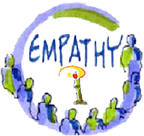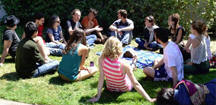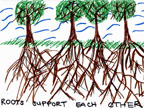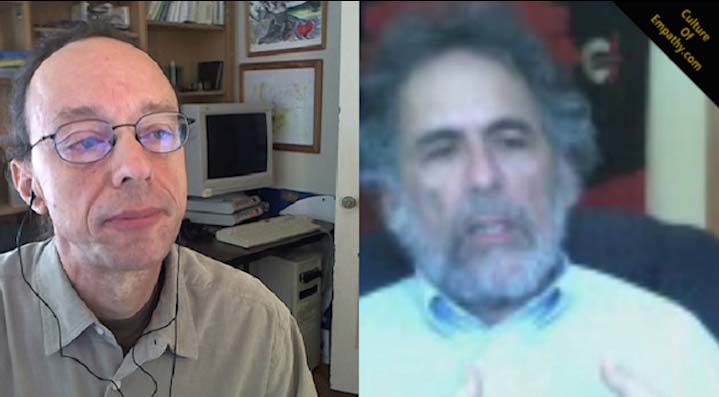|
|
|
Culture of Empathy Builder:
Stanley Davis
Transcripts
We video tape a lot of interviews
and empathy conference panels. It's helpful to have a transcript
of these videos since it makes it easier for viewers to quickly
access the information
Visit this page for instructions on how to do it.
You will
be contributing to the viewers ease of use and personal growth as
well as helping to build a culture of empathy and compassion.
We are grateful to you for your help!
E- Edwin Rutsch S- Stan Davis
00.00 Introduction E- Met Stan through Ashoka, Change makers website. We are both “expert” commentators on the competition about the best practises for developing empathy in schools!
S- I spent 20 years as a child and family therapist and 20 years as a school councillor. Meeting kids with this empathy component was important all through. How can we develop that and also nurture the empathy within kids already? Word ‘bullying’ is restrictive as it implies intention to hurt, but it’s often just careless behaviour. We need to- 1. Reduce hurtful behaviour 2. Increase resiliency in those affected since we can never eliminate meanness totally.
02.20- · Youth Voice Project- Gathered information re. Mistreatment in schools. Traditional advice was- ‘Cut it out’, punch them or pretend it doesn’t bother you and walk away, etc. Advice also given to peers who witnessed it, but how well does the advice work in real life? Cerise Nixon at Penn state and I made a questionnaire for 13,000 kids. Focused on 3000 of them that had been mistreated regularly. Asked which of the traditional advice they’d tried out and had it worked? Also what had peers and adults done and those outcomes?
Still putting data together but very clear directions coming from this- Much traditional advice not helpful, only worked for 1/5 kids who said “stop”. More kids said adult/ peer intervention helped and as they got older were able to tell themselves it was the perpetrators characteristic and not their fault., which helped.
Helpful actions by peers and adults that made difference were support and inclusive actions, but not confrontation as afraid of repercussions. Therefore many kids stuck between compassion and inaction, which means empathy for the target of meanness reduces over time since the peers don’t know how to act and they tell themselves the target probably deserves meanness or there's nothing that can be done anyway to prevent themselves from feeling bad.
Finding support for the 85% of kids in any school who want things to stop is very important. Mistreated kids want friendship, inclusion, emotional support and encouragement, even if it’s only a call at home to avoid trouble at school. The kids say this is actually more helpful than any confrontations at school.
Exciting! We can sustain level of empathy and concern that younger kids have for mistreated peers by helping them find safe, positive ways of helping, and they can sustain the level of empathy into adulthood rather than lose it.
06.04- E- We see this bullying behaviour for example in congress, it influences overall societal values. How can we make empathy a firm social value? How do we transform actual situations like these at school, to encourage empathic outcomes? What’s the best way to transform this- Saying don’t do it without reinforcing the dominance and power dynamic of the bully. Engage in a dialogue with the bully?
07.55- S- We must stop using the word ‘bully’, as there is no one meaning for the word, It’s an umbrella term and not useful. Kids are mean for many reasons and need to helped accordingly-
1. Social modelling/ Imitative behaviour from family or TV. These kids are the largest group and may have no character floors, just natural imitation socialises them into mean behaviour. They are helped by media education so they begin to see the models they are influenced by. e.g. The discovery exercise- a. list all favourite TV shows b. think and write about value you want to live by and your life’s direction c. put a + mark by all the shows in your list that are like that and a – mark by the ones that aren’t. A teacher said they were very shaken by the result and in a more conscious state to change behaviour.
Also information gathering to see how much people want to change small things like comment-‘ That’s so gay’. Often underestimate how many want to change these ‘social norms’. Very powerful feedback for students. Small consequences, e.g. a letter to parents re. exclusion from communal lunchtime is enough to create boundaries needed and discourage a whole class of behaviours.
These actions dramatically change things for this group who have natural empathy.
2. Second category of kids being mean have some impairment. E.g. very impulsive or don’t quite get the emotions of others, haven’t got cognitive empathy (These are the 2 halves of empathy) and don’t realise they are hurting others. Or don’t know how to deal with a situation where they want a little more power and only know to attack verbally/ physically. These kids need more work. Same work as above but also extra time with a school councillor to help them process their actions and the impact on others. What other action could they have taken, etc? e.g. Expressing frustration- did they want to be heard/admired? Common motivations. Was something else troubling them in their life? Need to practise other actions to these triggers.
3, Last group can do most harm, but a very tiny percentage. They are more stereotypical bullies, have superb social and cognitive skills and are calculating in using their knowledge of others feelings to do them harm. Cognition, but don’t feel empathy or it’s unimportant to them. ‘Split empathy’, an almost scientific detachment, prodding things in a lab. Helping these kids to feel is a long term project. There's sometimes a biological or brain injury element, or a foetal alcohol element, or severe trauma element. The first job is harm reduction to others whilst we try to change them, but we don’t have high expectations of change in short term.
E- We have to be more specific about bullying to find correct remedies.
17.43- S- A useful parallel is Drinking and driving. Which has potential for harm yet almost nothing to do with the person’s intention whether they are alcoholic or one of a tiny group of sociopaths. We have one initial rule to approach everyone with- don’t drink and drive. I.e. Penalty and education. But the habitual ones we then look for elements of addiction or the will to hurt, which will need different intervention. There is no actual word for Drink driver because its such a diverse group of people.
E- Differentiate meanness from bullying.
S- ‘Potentially harmful behaviour’ is the phrase I like best because we know certain things are likely to harm others and more or less agree on those things- ‘the reasonable person test’. It doesn’t imply intent or that someone harmed, but if you do this there's a potential for harm. We shouldn’t have to prove harm to not do it like no one hurt yet, so do it, but you don’t because it increases the likelihood of harm. This is also a way of building empathy with kids- asking them if someone has been hurt ( this is on the child level) as opposed to realising likelihood of someone being hurt, even if that hasn’t happened yet, (which is the more cognitively advanced level).
20.55- E- We need to create a positive vision to aspire to. Empathy is not on and off, its on a scale, were never 100%, but we can do our best to raise our level. Partly it’s intention. What will human interactions look like if we are in an empathy rich environment?
21.45- S- We should look at Ghandi. I spent time at his ashram and realised that we’ve really misunderstood the word non-violence in the west. Just saying ‘He didn’t hit’ (Martin Luther King) is not enough. Describing non-violence, the two words Ghandi used most in Hindi, were- ‘The force of truth’, and ‘Universal love’. i.e.- ‘An obligation to speak the truth in a loving way’. A lovely definition of where we can go with this, concerned with what’s best for me and you, taking time to blend them. ‘Love your neighbour as yourself’, not more or less than yourself. Advertisers who dropped Rush Limbaugh after his sexist comments were very empathic, thought outside himself and imagined his own daughter receiving this behaviour, rather than his profits. Putting self in someone else’s heart.
23.50- Initially teach children to decode visual clues regarding others, (using different faces). Ask them- 1. What is the person thinking? 2. Is there a link between what I did and how they think/feel? 3. Over time ripen process not just from cognitive but into emotive, so the child feels an echo of what another feels. It becomes harder to hurt because you feel things almost as much yourself.
24.55- But we have to also honour peoples own needs in addition to advancing things for other people- How? Ury and Fisher book- ‘Getting to Yes’, negotiating agreements without giving in, dealing with conflict so that the outcome, as much as possible meets both peoples needs and sustains the relationship. This ripples out and makes a big difference.
25.30- E- ‘Common humanity’ term, seeing each other’s humanity, for you and me, we need to foster this in society. Berkeley study in greed. Creating an environment where greed is good equals people following the rules of the ‘game’. The social norm is greed is good and therefore prevents us seeing one another’s humanity. So just need to change the rules.
26.44- S- Melvin Lerner’s 1960’s experiment, ‘Just road theory’, defined blaming people being shouted at for their own misfortune, which meant they could justify inaction. E.g.- making up a whole fictional history for homeless people, ‘they made their own bed’. However, not commonly known from this experiment that when people were told by the person in authority not to blame the person being shouted at, it changed the outcome. Very explicit statements from trusted/ authority figures can be very positive.
29.15- Food stamps and sponging from society. Accurate and honest storytelling helps. TV showed a single father sincerely struggling and making huge sacrifices for his children, we can relate to him and his child’s concern for starving father. Talking about poverty less in abstract and more in human terms promotes an empathic culture.
31.25- E- Occupy movement talks about non-violence. I’m uncomfortable with the word, it supports the existing paradigm re. people self-serving and violent rather than ‘common humanity’ and fostering empathy to create connections between all around, protestors/ police/ etc.
32.26- S- Martin Luther King and other non-violent protestors in the US fostered this within the word too, seeing common humanity in the police. And Ghandi said to the UK Prime minister- ‘I’m doing this because I know it will be better for England to let us go and be a colony, it’s not just for us’. Look up the Ghandi/ King institute online, folks are trying to portray the true Ghandi message, there's some very interesting dialogues on there.
|
||||||
|
||||






